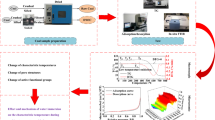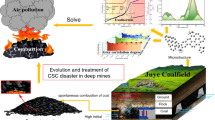Abstract
When a shallow-buried close-distance coal seam group is mined, the residual coal in the goaf of the upper coal seam is immersed in water for a prolonged period of time, increasing the risk of coal spontaneous combustion (CSC). In this study, the macroscopic characteristics of water-soaked coal (WSC) during low-temperature oxidation were analyzed using a temperature-programmed device. The microstructure changes at different oxidation temperatures (40, 80, 120, 160, and 200 °C) were investigated through liquid nitrogen adsorption and X-ray diffraction. The results revealed that, during low-temperature oxidation, macroscopic characteristic parameters such as the oxidation gas product concentration, temperature, and oxygen consumption rate of WSC changed, indicating higher oxidizability and lower apparent activation energy. The average pore size and macropore volume of the coal surface gradually increased during low-temperature oxidation. The mesopore volume increased at first and then tended to stabilize. The mineral content on the surface of the coal markedly diminished, but the mineral content did not participate in the oxidation process. Water leaching enhanced the interlayer spacing of the aromatic lamellae of the coal samples, curtailed the degree of coalification, and condensed the aromatic ring of the coal sample during the oxidation process. This analysis of the oxidation and macroscopic characteristics of WSC from micro- and macroperspectives is valuable for the prevention and containment of CSC.









Similar content being viewed by others
References
Deng J, Zhao JY, Huang AC, Zhang YN, Wang CP, Shu CM. Thermal behavior and microcharacterization analysis of second-oxidized coal. J Therm Anal Calorim. 2017;127(1):439–48. https://doi.org/10.1007/s10973-016-5493-8.
Li B, Liu G, Gao W, Cong HY, Bi MS, Ma L, et al. Study of combustion behaviour and kinetics modelling of Chinese Gongwusu coal gangue: Model-fitting and model-free approaches. Fuel. 2020;268:117284. https://doi.org/10.1016/j.fuel.2020.117284.
Wang CP, Deng Y, Zhang YT, Xiao Y, Deng J, Shu CM. Coal oxidation characteristics and index gases of spontaneous combustion during the heating and cooling processes. Fuel. 2022;307:121806. https://doi.org/10.1016/j.fuel.2021.121806.
Deng J, Bai ZJ, Xiao Y, Shu CM, Laiwang B. Effects of imidazole ionic liquid on macroparameters and microstructure of bituminous coal during low-temperature oxidation. Fuel. 2019;246:160–8. https://doi.org/10.1016/j.fuel.2019.02.066.
Zhai XW, Ge H, Wang TY, Shu CM, Li J. Effect of water immersion on active functional groups and characteristic temperatures of bituminous coal. Energy. 2020. https://doi.org/10.1016/j.energy.2020.118076.
Song S, Qin BT, Xin HH, Qin XW, Chen K. Exploring effect of water immersion on the structure and low-temperature oxidation of coal: a case study of Shendong long flame coal. China Fuel. 2018;234:732–7. https://doi.org/10.1016/j.fuel.2018.07.074.
Yang YL, Li ZH, Si LL, Gu FJ, Zhou YB, Qi QQ, et al. Study governing the impact of long-term water immersion on coal spontaneous ignition. Arab J Sci Eng. 2017;42(4):1359–69. https://doi.org/10.1007/s13369-016-2245-9.
Zha XW, Pan WJ, Wu SB, Ge H. Laboratory experimental study on water-soaked-dried bituminous coal’s thermal properties. J Therm Anal Calorim. 2020;139:3691–700. https://doi.org/10.1007/s10973-019-08769-6.
Sun LL, Zhang YB, Wang Y, Liu QQ. Study on the reoxidation characteristics of soaked and air–dried coal. J Energ Resour Technol. 2018;141(2):022203. https://doi.org/10.1115/1.4041407.
Xu YL, Bu YC, Chen ML, Wang LY. Effect of water-immersion and air-drying period on spontaneous combustion characteristics for long-flame coal. Combust Sci Technol. 2020;1(5):1–16. https://doi.org/10.1080/00102202.2020.1788007.
Wang CP, Yang NN, Xiao Y, Bai ZJ, Deng J, Shu CM. Effects of moisture and associated pyrite on the microstructure of anthracite coal for spontaneous combustion. ACS Omega. 2020;5(42):27607–17. https://doi.org/10.1021/acsomega.0c04161.
Fry R, Day S, Sakurovs R. Moisture-induced swelling of coal. Int J Coal Prep Util. 2009;29(6):298–316. https://doi.org/10.1080/19392690903584575.
Nakagawa H, Namba A, Böhlmann M, Miura K. Hydrothermal dewatering of brown coal and catalytic hydrothermal gasification of the organic compounds dissolving in the water using a novel Ni/carbon catalyst. Fuel. 2004;83(6):719–25. https://doi.org/10.1016/j.fuel.2003.09.020.
Yu J, Tahmasebi A, Han Y, Yin F, Li X. A review on water in low rank coals: the existence, interaction with coal structure and effects on coal utilization. Fuel Process Technol. 2013;106(2):9–20. https://doi.org/10.1016/j.fuproc.2012.09.051.
Deevi SC, Suuberg EM. Physical changes accompanying drying of western US lignites. Fuel. 1987;66(4):454–60. https://doi.org/10.1016/0016-2361(87)90147-5.
Suuberg EM, Otake Y, Yun Y, Deevi SC. Role of moisture in coal structure and the effects of drying upon the accessibility of coal structure. Energ Fuel. 1993;7(3):384–92. https://doi.org/10.1021/ef00039a009.
Li B, Ren YJ, Lv XQ. The evolution of thermal conductivity and pore structure for coal under liquid nitrogen soaking. Civ Eng Adv. 2020. https://doi.org/10.1155/2020/2748092.
Sakurovs R, Lewis C, Wibberley L. Effect of heat and moisture on surface titratability and pore size distribution of Victorian brown coals. Fuel. 2016;172:124–9. https://doi.org/10.1016/j.fuel.2016.01.004.
Wu Y, Zhang Y, Wang J, Zhang X, Wang J, Zhou C. Study on the effect of extraneous moisture on the spontaneous combustion of coal and Its mechanism of action. Energies. 2020;13(8):1969. https://doi.org/10.3390/en13081969.
Bai ZJ, Wang CP, Deng J, Kang FR, Shu CM. Effects of ionic liquids on the chemical structure and exothermic properties of lignite. J Mol Liq. 2020. https://doi.org/10.1016/j.molliq.2020.113019.
Yin L, Xiao Y, Zhong KQ, Shu CM, Tian Y. Temperature effects on thermal diffusivity of bituminous coal using different pre-oxidation levels in a nitrogenous atmosphere. Fuel. 2021. https://doi.org/10.1016/j.fuel.2020.119640.
Wen G, Yang S, Liu Y, Wu W, Sun D, Wang K. Influence of water soaking on swelling and microcharacteristics of coal. Energy Sci Eng. 2020;8(1):50–60. https://doi.org/10.1002/ese3.508.
Kücük A, Kadıoğlu Y, Gülaboğlu MŞ. A study of spontaneous combustion characteristics of a Turkish lignite: particle size, moisture of coal, humidity of air. Combust Flame. 2003;133(3):255–61. https://doi.org/10.1016/S0010-2180(02)00553-9.
Cai JW, Yang SQ, Hu XC, Song WX, Xu Q, Zhou BZ, et al. Forecast of coal spontaneous combustion based on the variations of functional groups and microcrystalline structure during low-temperature oxidation. Fuel. 2019;253:339–48. https://doi.org/10.1016/j.fuel.2019.05.040.
Xu JC. Determination theory of coal spontaneous combustion zone. China Coal Industry Publishing House, Beijing, China. 2001(in Chinese).
Deng J, Chen WL, Liang C, Wang WF, Xiao Y, Wang CP, et al. Correction model for co detection in the coal combustion loss process in mines based on gwo-svm. J. Loss Prev. Process Industries. 2021;71:104439. https://doi.org/10.1016/j.jlp.2021.104439.
Huang ZA, Li JY, Gao YK, Shao ZL, Zhang YH. Thermal behavior and microscopic characteristics of WSC spontaneous combustion. Combust Sci Technol. 2020;6:1–19. https://doi.org/10.1080/00102202.2020.1777993.
Cui CB, Jiang SG, Zhang WQ. Influence of different concentrations of ionic solutions on coal spontaneous combustion. Combust Sci Technol. 2018;190:1817–31. https://doi.org/10.1080/00102202.2018.1473860.
Zhou CS, Zhang YL, Wang JF, Xue S, Wu JM. Study on the relationship between microscopic functional group and coal mass changes during low-temperature oxidation of coal. Int J Coal Geol. 2017;171:212–22. https://doi.org/10.1016/j.coal.2017.01.013.
Chen XX, Shan WX, Sun RB, Zhang L. Methane displacement characteristic of coal and its pore change in water injection. Energ Explor Exploit. 2020;38:1647–63. https://doi.org/10.1177/0144598720934052.
Sing KSW. Reporting physisorption data for gas/solid systems with special reference to the determination of surface area and porosity. Pure Appl Chem. 1985;57(4):603–19. https://doi.org/10.1351/pac198557040603.
Yang YL, Li ZH, Tang YB, Ji HJ, Liu Z. Soluble organic matter affecting low temperature oxidation of coal with different ranks. Asian J Chem. 2014;26:2487–92. https://doi.org/10.14233/ajchem.2014.16687.
Zheng QM, Liu QF, Wu ZG, Zhang YM, Shi SL. Ammonium-illite smectite interlayer clay minerals in coal-bearing strata in Jincheng district of Shanxi Province. J China Coal Soc. 2012;37(2):231–6.
Norinaga K, Hayashi JI, Kudo N, Chiba T. Evaluation of effect of predrying on the porous structure of water-swollen coal based on the freezing property of pore condensed water. Energ Fuel. 1999;13(5):1058–66. https://doi.org/10.1021/ef990024v.
Chen M, Zhang SY, Li Y, Li H, Wu SY, Huang XH. Evolution of microstructure and combustion reactivity of lignite during high-temperature drying process. Dry Technol. 2018;36(10):1170–8. https://doi.org/10.1080/07373937.2017.1390477.
Li ZH, Wei AZ, Yang YL. Research on free radical reactions in spontaneous combustion of coal using an electron spin resonance. J China U Min Technol. 2006;35(5):576–80. https://doi.org/10.1093/carcin/bgm010.
Pilawa B, Więckowski A, Pietrzak R, Wachowska H. Oxidation of demineralized coal and coal free of pyrite examined by EPR spectroscopy. Fuel. 2002;81(15):1925–31. https://doi.org/10.1016/S0016-2361(02)00131-X.
Yu S, Jiang B, Liu JG. Nanopore structural characteristics and their impact on methane adsorption and diffusion in low to medium tectonically deformed coals: case study in the Huaibei coal field. Energ Fuel. 2017;31(7):6711–23. https://doi.org/10.1021/acs.energyfuels.7b00512.
Choi H, Thiruppathiraja C, Kim S, Rhim Y, Lim J, Lee S. Moisture readsorption and low temperature oxidation characteristics of upgraded low rank coal. Fuel Process Technol. 2011;92(10):2005–10. https://doi.org/10.1016/j.fuproc.2011.05.025.
Vorres KS, Wertz DL, Malhotra V, Dang Y, Joseph JT, Fisher R. Drying of Beulah-Zap lignite. Fuel. 1992;71(9):1047–53. https://doi.org/10.1016/0016-2361(92)90113-3.
Takagi H, Maruyama K, Yoshizawa N, Yamada Y, Sato Y. XRD analysis of carbon stacking structure in coal during heat treatment. Fuel. 2004;83(17/18):2427–33. https://doi.org/10.1016/j.fuel.2004.06.019.
Li KJ, Khanna R, Zhang JL, Barati M, Liu ZJ, Xu T, et al. Comprehensive investigation of various structural features of bituminous coals using advanced analytical techniques. Energ Fuel. 2015;29(11):7178–89. https://doi.org/10.1021/acs.energyfuels.5b02064.
Wang Y, Zhang Y, Zhou Q, Zhang Y, Sun J. Thermal kinetics analysis of coal-gangue selected from Inner Mongolia in China. J Therm Anal Calorim. 2018;131(2):1835–43. https://doi.org/10.1007/s10973-017-6642-4.
Sonibare OO, Haeger T, Foley SF. Structural characterization of Nigerian coals by X-ray diffraction Raman and FTIR spectroscopy. Energy. 2010;35(12):5347–53. https://doi.org/10.1016/j.energy.2010.07.025.
Liu H, Jiang WB, Liu JG, Song Y. The evolutionary characteristics and mechanisms of coal chemical structure in micro deformed domains under sub-high temperatures and high pressures. Fuel. 2018;222:258–68. https://doi.org/10.1016/j.fuel.2018.02.117.
Shi QL, Qin BT, Bi Q, Qu B. An experimental study on the effect of igneous intrusions on chemical structure and combustion characteristics of coal in Daxing Mine. China Fuel. 2018;226:307–15. https://doi.org/10.1016/j.fuel.2018.04.027.
Bai ZJ, Wang CP, Deng J, Kang FR, Shu SM. Experimental investigation on using ionic liquid to control spontaneous combustion of lignite. Process Saf. Environ. Prot. 2020;142:138–49. https://doi.org/10.1016/j.psep.2020.06.017.
Lei ZP, Wu L, Zhang YQ, Shui HF, Wang ZC, Ren SB. Effect of noncovalent bonds on the successive sequential extraction of Xianfeng lignite. Fuel Process Technol. 2013;111:118–22. https://doi.org/10.1016/j.fuproc.2013.02.004.
Acknowledgements
This project was supported by National Natural Science Foundation of China (Nos. 51774232 and 51974234), Shaanxi International Science and Technology Cooperation Project (No. 2020KW-026), Scientific Research Projects of Sichuan Provincial Department of Science and Technology (2021SCLL02), and Luzhou Science and Technology Planning Project (No. 2021-SYF-42). The authors also gratefully acknowledge Key Laboratory of Coal Fire and Hazard Prevention in Shaanxi Province, China.
Author information
Authors and Affiliations
Contributions
Yong-Jun He contributed to writing—original draft. Jun Deng and Xiao-Wei Zhai contributed to funding acquisition, supervision, and investigation. Zu-Jin Bai and Yang Xiao contributed to supervision and investigation. Chi-Min Shu contributed to supervision.
Corresponding authors
Additional information
Publisher's Note
Springer Nature remains neutral with regard to jurisdictional claims in published maps and institutional affiliations.
Rights and permissions
About this article
Cite this article
He, YJ., Deng, J., Zhai, XW. et al. Experimental investigation of the macroscopic characteristic parameters and microstructure of water-soaked coal during low-temperature oxidation. J Therm Anal Calorim 147, 9711–9723 (2022). https://doi.org/10.1007/s10973-022-11243-5
Received:
Accepted:
Published:
Issue Date:
DOI: https://doi.org/10.1007/s10973-022-11243-5




